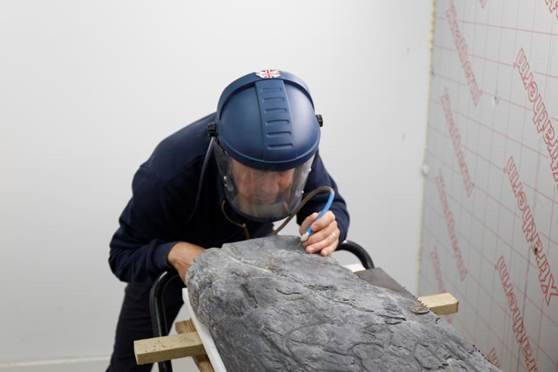Collections Care and Conservation Manager Christopher Weeks describes work to conserve a Manx Cross
Osruth’s Cross has stood in the porch of the Royal Chapel in St John’s since the church was built in the mid nineteenth century. The cross itself is one thousand years old and was originally much taller, possibly with round cross head on top. This cross is just one of over two hundred that have recently been recorded in 3D.
Recently the cross had become loose in the porch floor. It was removed to our workshops on the 15th May 2019 where work has now begun to clean and consolidate it prior to its redisplay in the Royal Chapel.
Once back at the Manx Museum it was possible to examine the cross more closely. The stone is very fragile and some fragments of the carving are loose. The lower part of the cross has been repaired in the past with cement, plaster of Paris and car body filler, all of which have badly damaged the underlying stone. All need to be removed, so samples were taken and examined under the microscope to confirm their composition. The top and sides of the cross are spattered with paint. There are numerous crayon marks on the carved surfaces, in various colours.
Figure 1: Osruth’s Cross in the Porch of the Royal Chapel
Figure 2: Removing the cross
Figure 3: Back in the workshop – poor past repairs
Figure 4: Damage done by car body filler & cement (pink)
Removal of Old Repairs
The bulk of this work was done with a hammer and chisel. A hard cement layer overlying the original 19th century repair mortar was very hard and tenaciously bound to the stone either side of the repair joint. It may have been applied in a misguided attempt to strengthen the crumbling stone.
Figure 5: Removing the cement
Micro air abrasion is a bit like sand blasting on a tiny scale, using fine powder instead of sand. It is usually very effective at removing hard accretions but in this case it was exceedingly difficult to avoid damaging the soft stone underneath; the stone overlain by cement is very badly damaged.
Figure 6: Using the micro air abrasive to remove hard repair residues
Much of the remaining, shallow skim of cement was removed, under magnification, with a scalpel. Tests with a solvent confirmed much of the grey restoration material was car body filler. The solvent softened them which helped with their removal.
Wax Crayon Marks
In the past and to a lesser extent today, visitors have taken rubbings of the crosses using wax crayons. This is now strongly discouraged because of the fragility of the crosses which is not always apparent. The practise has also resulted in many of the crosses being disfigured by wax crayon marks. The orange crayon on Osruth’s Cross proved extremely difficult to remove. After tests of solvent compresses and chemical strippers all failed, the wax was eventually removed using a dental steam cleaner and scalpel under magnification.
Figure 7: During removal of wax crayon
Figure 8: After removal of wax crayon
Paint Spatter
Several times the porch interior has been decorated without first protecting the cross. Consequently it is covered in tiny spots and drips of paint, especially on the top and sides. The age of the paint probably contributes to the difficulty of its removal. The specks and drips are very hard and are tightly bound to the stone, much of which is loose and crumbly. To complicate this, the jagged relief of the top of the cross (a break edge formed by the loss of the cross head in the distant past) makes the application of a stripper very difficult. So far only removal with a scalpel under magnifications has been effective, and often even this leaves a disfiguring residue.
The work to conserve Osruth’s Cross continues. When cleaning is complete we will begin trials of consolidants to strengthen the crumby stone and of soft mortars to support loose fragments. Luckily there’s plenty of decaying Manx stone lying around on beaches we can practise on!
Manx National Heritage has published 3D laser scans of over two hundred Manx Crosses which can be viewed at https://sketchfab.com/manxnationalheritage.
Christopher Weeks ACR (Manx National Heritage Collections Care and Conservation Manager)
Blog Archive
- Edward VII’s Coronation Day in the Isle of Man (9 August 1902)
- Victoria’s Coronation Day in the Isle of Man (28 June 1838)
- Second World War Internment Museum Collections
- First World War Internment Museum Collections
- Rushen Camp: Second World War Internment on the Isle of Man
- Hutchinson, Onchan & Peveril Camps: Second World War Internment on the Isle of Man
- Douglas Promenade: Second World War Internment on the Isle of Man
- Mooragh Camp: Second World War Internment on the Isle of Man
- Sculpture collection newly released to iMuseum
- Fishing Folklore: how to stay safe & how to be lucky at sea
- News from the gaol registers project: remembering the men and women who served time in Castle Rushen
- Explore Mann at War: stories of Manx men, women and children in conflict
- We Will Remember Them: Isle of Man Great War Roll of Honour (1914-1918)
- Dr Dave Burnett explores Manx National Heritage geology collection
- Unlocking stories from the Archives: The Transvaal Manx Association
- Login to newspapers online: step-by-step guidance
- ‘Round Mounds’ Investigation Reveals Rare Bronze Age Object








